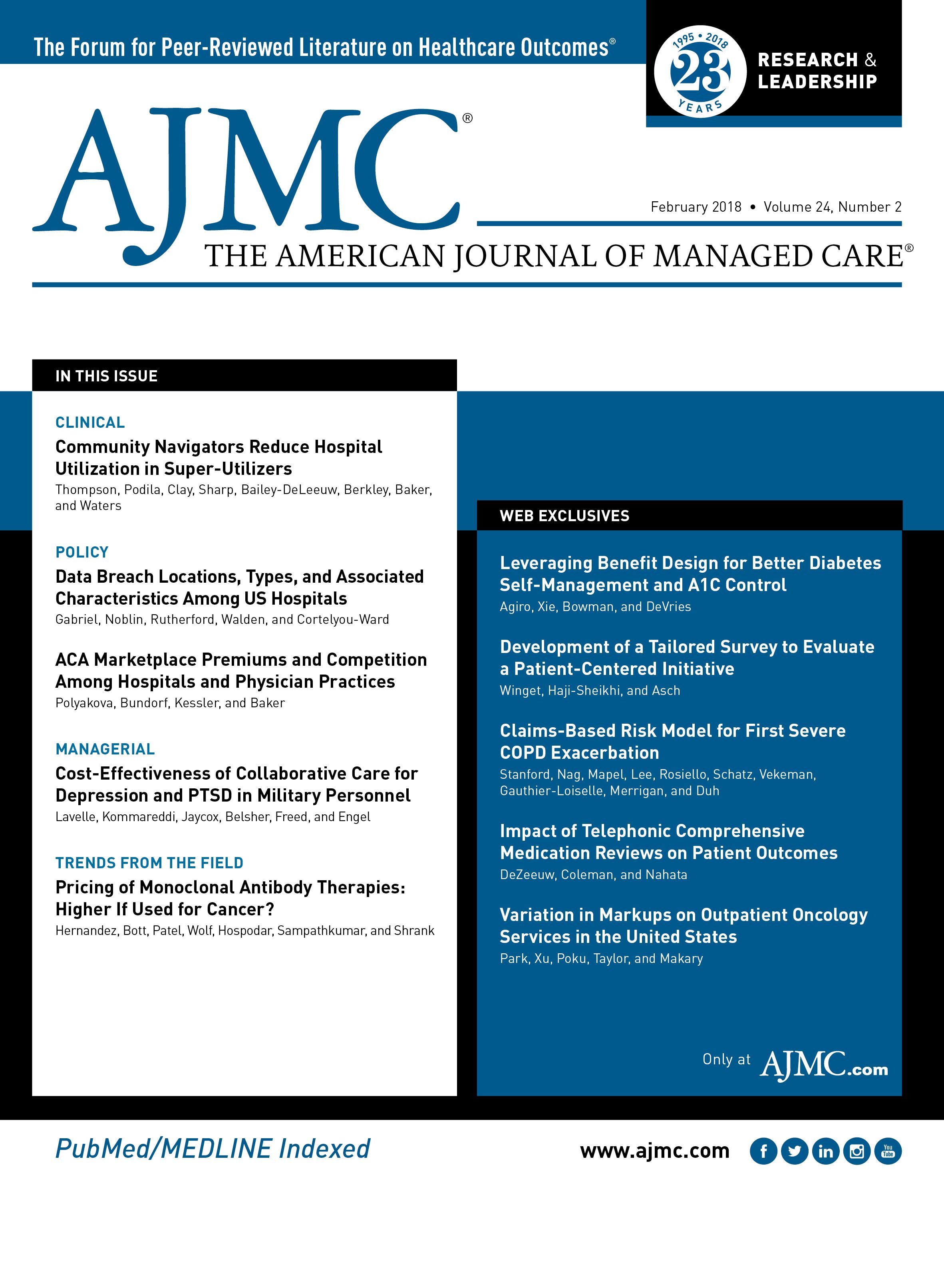Publication
Article
The American Journal of Managed Care
Variation in Markups on Outpatient Oncology Services in the United States
Author(s):
Charges for oncology services vary widely across hospitals and impose financial burdens. Further legislation is needed to address disparities in access to high-quality cancer care.
ABSTRACT
Objectives: Price markups are a major cause of healthcare inflation and financial harm to patients, especially those who are self-paying or covered by commercial insurance.
Study Design: Retrospective analysis of publicly-available information on Medicare physician payments, representing 100% of Part B services provided to fee-for-service beneficiaries during calendar year 2014.
Methods: Outcomes were markup ratios for oncology services, defined as the ratio of submitted charges to the amount reimbursed by Medicare. For example, the overall cost-to-charge ratio for all Medicare-reimbursed services in 2013 was 3.4, or a 240% charge markup.
Results: Our analysis included oncology services provided by 3248 hospitals in all 50 states. There was significant variation in markup ratios by hospital across oncology specialty: radiology (median = 3.7; interquartile range [IQR], 3.1-4.5), hematology/oncology (median = 2.3; IQR, 1.8-2.9), medical oncology (median = 2.4; IQR, 1.8-3.0), pathology (median = 4.1; IQR 3.1-5.1), and radiation oncology (median = 3.6; IQR, 2.9-4.5). Higher markups were associated with for-profit status for medical oncology services (coefficient, 0.29; 95% CI, 0.12-0.45) and prestige status for radiology (0.53; 95% CI, 0.15-0.92) and pathology (0.65; 95% CI, 0.20-1.09) services.
Conclusions: High markups exist for oncology services, and further legislation is needed to protect patients from highly variable pricing and to address disparities in access to high-quality cancer care.
Am J Manag Care. 2018;24(2):e59-e60Takeaway Points
Disparities in access to high-quality cancer care and rising treatment costs continue to worsen the problem of patient out-of-pocket expenses for cancer care.
- There is significant variation in markup of services by hospital across oncology specialties (radiology, hematology/oncology, medical oncology, pathology, and radiation oncology).
- Higher markups were associated with for-profit status for medical oncology services and prestige status for radiology and pathology services.
- These findings support further efforts to protect uninsured and out-of-network patients from highly variable pricing.
Rising treatment costs, very high health insurance deductibles, and narrowing insurance networks have magnified the problem of patient out-of-pocket expenses for cancer care.1 As many as 8% of all patients will seek care from an out-of-network specialist and may be held responsible for chargemaster, or “sticker,” prices.2 This occurs when the patient does not realize they are seeing an out-of-network physician (“surprise medical bill”) or when patients deliberately choose out-of-network facilities, which is common in oncology. Charges for the same service can vary widely across hospitals and create significant financial burdens on patients with cancer.2 To better understand the financial hardships that patients can face, we designed a study to characterize the variation in what hospitals charge for outpatient oncology services.
We assessed price markup variation by hospital and by oncology specialty using 2014 Medicare Part B physician reimbursement data from CMS.2 Claims were linked by National Physician Identifiers to the Physician Compare database to identify each physician’s primary hospital affiliation. We obtained hospital characteristics from the American Hospital Association database, including size, for-profit status, location, and academic status, and defined prestigious hospitals as those listed among the 2014 US News & World Report’s Hospital Honor Roll. The markup ratio was defined as the charge billed divided by the Medicare allowable amount, as in previous studies.2 Thus, a markup ratio of 3.5 means that for every $100 that Medicare pays, the hospital charged $350, or $250 in excess charges. We used multivariable linear regression to study hospital characteristics associated with higher markups. This study was exempted by the Johns Hopkins Institutional Review Board as not being human subjects research.
Of the 3248 hospitals from all 50 states identified in our analysis, 60% had fewer than 200 beds, 19% were for-profit, 37% were academic, and 2% had prestige status. We found significant variation in markup ratios by hospital across oncology specialty: radiology (median = 3.7; interquartile range [IQR], 3.1-4.5), hematology/oncology (median = 2.3; IQR, 1.8-2.9), medical oncology (median = 2.4; IQR, 1.8-3.0), pathology (median = 4.1; IQR, 3.1-5.1), and radiation oncology (median = 3.6; IQR, 2.9-4.5) (Table). Higher markups were associated with for-profit status for medical oncology services (coefficient, 0.29; 95% CI, 0.12-0.45) and prestige status for radiology (0.53; 95% CI, 0.15-0.92) and pathology (0.65; 95% CI, 0.20-1.09) services.
Our findings contribute to emerging evidence that prestigious hospitals or large hospital chains use higher chargemaster pricing to “anchor” negotiations and gain higher reimbursement from insurers.3,4 In this way, price markups contribute to the inflation of medical costs in the healthcare system and can affect patients’ treatment decisions as their out-of-pocket costs increase.3 Patients who go out-of-network can be burdened by onerous collection processes that demand payment for more than what the hospital would receive from an in-network patient.5 This difference can be dramatic, representing a critical health disparity in cancer care. Moreover, patients are rarely able to select their radiologist or pathologist, which contributes to the phenomenon of surprise medical bills. On a moral level, we believe that it is unethical for a nonprofit medical center to put a patient with cancer into household bankruptcy because they cannot pay a bill inflated above what Medicare would pay for the identical service.
The recent trend toward narrower insurance networks increases the chance that patients will face high out-of-pocket costs from seeing an out-of-network specialist. One analysis of new federal Marketplace plans under the Affordable Care Act showed that 15% lacked in-network physicians altogether in at least 1 specialty.6 New patient protections are now emerging in several states to address this problem, with New York and other states passing legislation requiring that hospitals negotiate directly with insurers rather than bill patients chargemaster prices.2 Further legislation like that in New York may protect patients from this highly variable pricing and address disparities in access to high-quality cancer care.2Author Affiliations: Johns Hopkins Department of Surgery (AP, JT, MAM), Baltimore, MD; Johns Hopkins School of Medicine (TX, MP), Baltimore, MD.
Source of Funding: This study was supported by the Alpha Omega Alpha Carolyn L. Kuckein Student Research Fellowship. The funder had no role in the design and conduct of the study; collection, management, analysis, and interpretation of the data; preparation, review, or approval of the manuscript; or decision to submit the manuscript for publication.
Prior Presentation: An oral abstract has been presented at Medical Quality 2016 (March 30-April 2, 2016), hosted by the American College of Medical Quality.
Author Disclosures: The authors report no relationship or financial interest with any entity that would pose a conflict of interest with the subject matter of this article.
Authorship Information: Concept and design (TX, MP, JT, MAM); acquisition of data (AP, TX); analysis and interpretation of data (AP, TX, MP, JT); drafting of the manuscript (AP, TX); critical revision of the manuscript for important intellectual content (AP, TX, MP, JT, MAM); statistical analysis (AP, TX); obtaining funding (TX); and supervision (MAM).
Address Correspondence to: Martin A. Makary, MD, MPH, Johns Hopkins Department of Surgery, Halsted 610, 600 N Wolfe St, Baltimore, MD 21287. Email: mmakary1@jhmi.edu.REFERENCES
1. The costs of cancer: addressing patient costs. American Cancer Society Cancer Action Network website. acscan.org/sites/default/files/Costs%20of%20Cancer%20-%20Final%20Web.pdf. Published April 2017. Accessed May 22, 2017.
2. Xu T, Park A, Bai G, et al. Variation in emergency department vs internal medicine excess charges in the United States. JAMA Intern Med. 2017;177(8):1139-1145. doi: 10.1001/jamainternmed.2017.1598.
3. White C, Reschovsky JD, Bond AM. Understanding differences between high- and low-price hospitals: implications for efforts to rein in costs. Health Aff (Millwood). 2014;33(2):324-331. doi: 10.1377/hlthaff.2013.0747.
4. Batty M, Ippolito B. Mystery of the chargemaster: examining the role of hospital list prices in what patients actually pay. Health Aff (Millwood). 2017;36(4):689-696. doi: 10.1377/hlthaff.2016.0986.
5. Szabo L. As drug costs soar, people delay or skip cancer treatments. Shots. March 15, 2017. npr.org/sections/health-shots/2017/03/15/520110742/as-drug-costs-soar-people-delay-or-skip-cancer-treatments. Accessed September 25, 2017.
6. Dorner SC, Jacobs DB, Sommers BD. Adequacy of outpatient specialty care access in marketplace plans under the Affordable Care Act. JAMA. 2015;314(16):1749-1750. doi: 10.1001/jama.2015.9375. 







